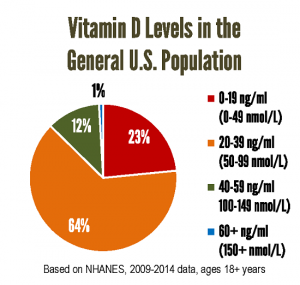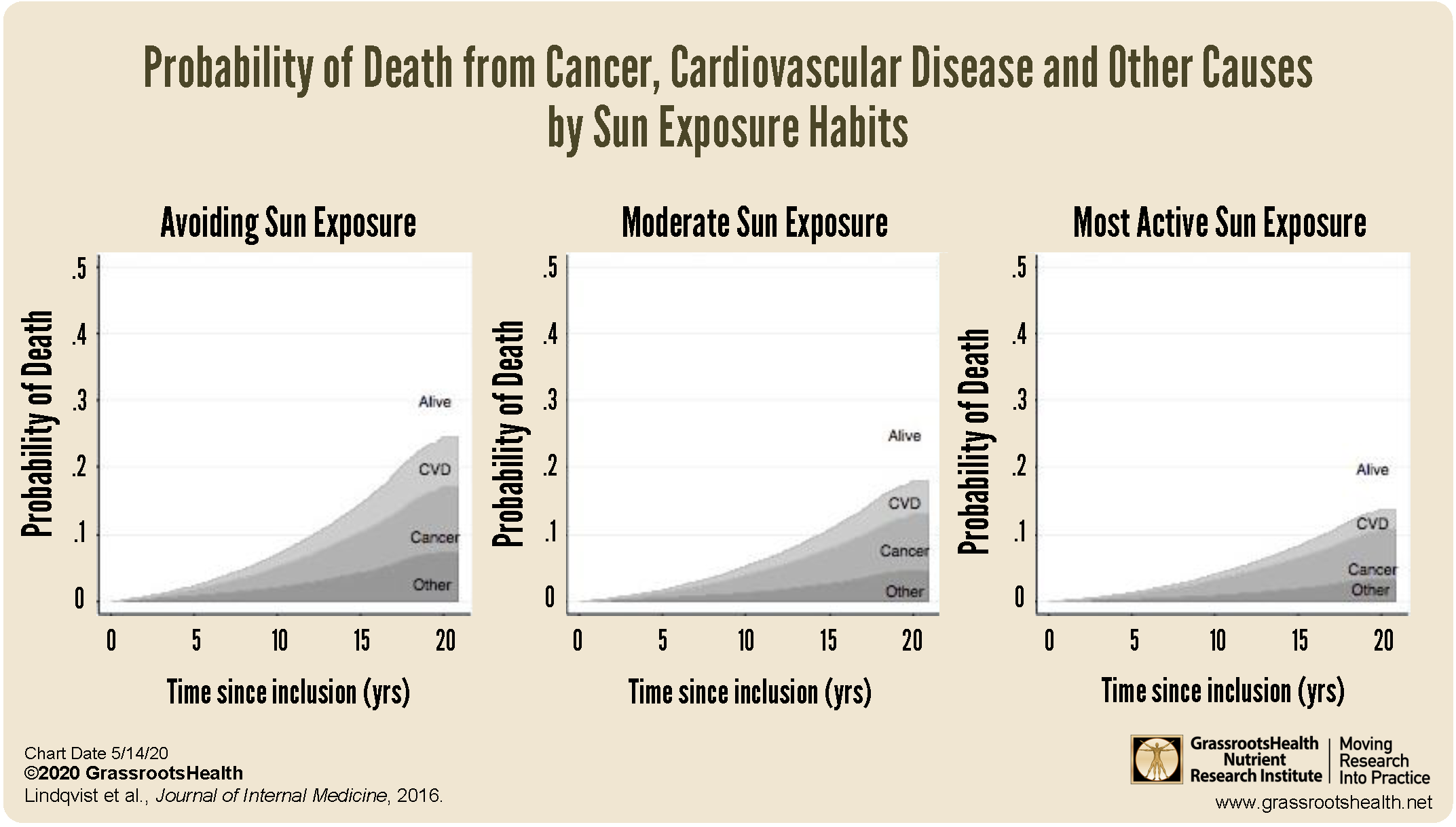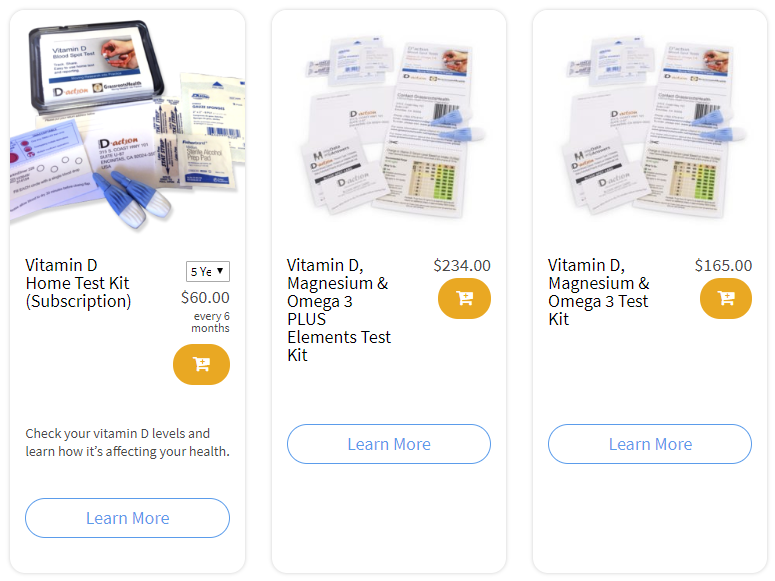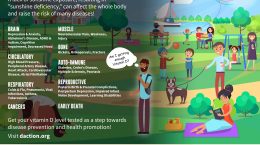Published on May 15, 2020
Current public health recommendations advise against sun exposure because it has been associated with an increased risk for skin cancer. While true for people with fair skin and a history of repeated sun burns, for the majority of the population, sensible sunshine exposure (in proper doses, without burning) has a positive impact on health and may protect against disease, helping people live longer.
Avoiding sun exposure increases mortality
A study of 29,518 Swedish women by Lindqvist et al. (2014) found that all-cause mortality was inversely related to sun exposure. The mortality rate for women who avoided sun exposure was two times higher that of those with the highest sun exposure, with an intermediate mortality rate in those with moderate sun exposure.
In a following analysis of the same group of women, Lindqvist et al. (2016) found that avoidance of sunshine resulted in a shorter life expectancy comparable to the shortened life expectancy of smokers. The lead author, Dr. Pelle Lindqvist, put it another way, “We found smokers in the highest sun exposure group were at a similar risk as non-smokers avoiding sun exposure, indicating avoidance of sun exposure to be a risk factor of the same magnitude as smoking.”
As can be seen in the charts above, those women with active sun exposure habits were at a lower risk of death from cardiovascular disease and causes of death other than cancer or heart disease, such as diabetes, multiple sclerosis and pulmonary disease. Compared to those with the highest sun exposure, life expectancy for women who avoided sun was shorter by 0.6 to 2.1 years.
The authors make a point that following sun exposure guidelines may not be optimal for people with darker skin or for people in countries that get limited sunshine and have a low UV index to begin with.
As Baggerly et al. (2015) remind us, human beings are physiologically adapted to synthesize vitamin D from the sun, therefore, sun exposure may be our most effective means of increasing our vitamin D levels as well as garnering benefits from the sun not supplied by supplements.
Newer research supports sunshine as protective against disease – for reasons beyond vitamin D
Sunlight includes both UVA and UVB rays. When the sun reaches the skin these UVA and UVB rays penetrate the skin and make small changes. UVA light from the sun increases nitric oxide production which stimulates vasodilation and lowers blood pressure, resulting in the reduction of cardiovascular events like heart attack and stroke. UVB rays increase production of beta-endorphins which promote a feeling of well-being and help regulate our sleep-wake cycles. Furthermore, UVB exposure is responsible for vitamin D production in the skin.
A 2019 review by Queiros and Freitas highlights the relationship between regular sun exposure and reduced incidence of cancers, autoimmune disease, cardiovascular diseases, diabetes, metabolic syndrome, obesity, autism, Alzheimer’s disease, and psychological illness – just to name a few. Similarly, in a commentary highlighting several known health risks associated with low vitamin D levels and lack of sun exposure, Hoel and De Gruijl (2018) conclude that moderate UV exposure from the sun, without burning, is a health benefit and should be recommended as such.
People following guidelines are at risk for vitamin D deficiency
 Public health recommendations against sun exposure may be causing more harm than good. As a result, according to the National Health and Nutrition Examination Survey (NHANES, 2009-2014) data, almost 90% of US adults are below 40-60 ng/ml (100-150 nmol/L), which is the level recommended by the GrassrootsHealth Scientists’ Panel!
Public health recommendations against sun exposure may be causing more harm than good. As a result, according to the National Health and Nutrition Examination Survey (NHANES, 2009-2014) data, almost 90% of US adults are below 40-60 ng/ml (100-150 nmol/L), which is the level recommended by the GrassrootsHealth Scientists’ Panel!
The cost of avoiding sunshine exposure
Hoel et al. (2016) point out the discrepancies that exist between public health recommendations to reduce sun exposure and the body of evidence that supports moderate sun exposure as beneficial for human health.
In fact, raising serum vitamin D concentrations may be the most efficient and cost-effective way to reduce the chronic disease burden in the US and increase life expectancy. Of the 30 leading causes of death in the US in 2010, 19 have been linked to low vitamin D status. If the US population were to increase their vitamin D levels to at least 40 ng/ml (100 nmol/L), we could expect to see a potential reduction of as much as 336,000 deaths per year and direct cost reductions upwards of $130 billion each year.
What are we waiting for? Help protect your overall health with proper sun exposure and test to make sure your vitamin D level is in the recommended range of 40-60 ng/ml (100-150 nmol/L)!
Do You Have Enough Vitamin D to Support a Healthy Immune System?
We’re in a time of great crisis that could be greatly affected by making sure you and everyone you know has a serum level of at least 40 ng/ml. Help us help you.
Do you know what your vitamin D level is? Be sure to test today to find out, and take steps to keep it within a target of 40-60 ng/ml or 100-150 nmol/L! Give your immune system the nutrients it needs to support a healthy you and protect yourself from unnecessary diseases.
GrassrootsHealth Nutrient Research Institute is preparing to do a Community RCT with the use of our myData-myAnswers nutrient health system that over 15,000 people are already using for their health. We will demonstrate how one can use the Nutrient Research Model established by Dr. Robert Heaney to establish the effect of vitamin D serum levels of at least 40 ng/ml (100 nmol/L) on risk reduction with different ethnicities in the population. Please let us know if you’re interested in helping sponsor this project.
Through GrassrootsHealth Nutrient Research Institute, you can also test your essential elements magnesium, copper, zinc and selenium, toxins such as lead, mercury and cadmium, as well as your omega-3 levels, inflammation levels and thyroid stimulating hormone (TSH) level. Find out your levels today! Log on to the test selection page (click the link below) to get your tests and see for yourself if your levels can be improved.
Make sure you track your results before and after, about every 6 months!
Click Here to Access the Test Page
How can I track my nutrient intake and levels over time?
To help you track your supplement use and nutrient levels, GrassrootsHealth has created the Personal Health Nutrient Decision System called
For each specific supplement, you can track what days you take it, how much, and many other details. This will help you know your true supplemental intake and what patterns of use work for you to reach and maintain optimum nutrient levels. Check it out today!









